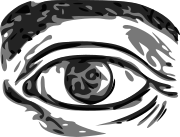Cordeliers Club Club des Cordeliers | |
|---|---|
 "Open-eye" logo used in some Cordelier publications | |
| Presidents | Georges Danton (1790–1791) Pierre-François-Joseph Robert (1791–1792) Jacques Hébert (1792–1794) |
| Founders | Georges Danton Camille Desmoulins |
| Founded | 27 April 1790 |
| Dissolved | 20 February 1795 |
| Headquarters | Cordeliers Convent, Paris |
| Newspaper | Le Vieux Cordelier (Dantonists) Le Père Duchesne (Hébertists) |
| Ideology | Jacobinism Populism[1] Direct democracy Radicalism |
| Political position | Left-wing to far-left |
| National affiliation | The Mountain (1792–1794) |
| Colours | |
| Slogan | Liberté, égalité, fraternité ("Liberty, equality, fraternity") |
| Party flag | |
 | |
| Part of a series on |
| Radicalism |
|---|
The Society of the Friends of the Rights of Man and of the Citizen (French: Société des Amis des droits de l'homme et du citoyen [sɔsjete dez‿ami de dʁwa də lɔm e dy sitwajɛ̃]), mainly known as Cordeliers Club (French: Club des Cordeliers [klœb de kɔʁdəlje]), was a populist political club during the French Revolution from 1790 to 1794, when the Reign of Terror ended and the Thermidorian Reaction began.
The club campaigned for universal male suffrage and direct democracy, including the referendum. It energetically served as a watchdog looking for signs of abuse of power by the men in power. By 1793, it was challenging the centralization of power by Robespierre and his Committee of Public Safety. They responded by arresting the leadership, charging them with conspiring to overthrow the Convention. The leaders were guillotined, and the club disappeared.
- ^ Ian Davidson, ed. (2016). The French Revolution: From Enlightenment to Tyranny. Profile Books. p. XIV. ISBN 9781847659361.
He was a sometime cabin boy and medical apprentice who had acquired a certain celebrity as an ultra-revolutionary speaker in the populist Cordeliers Club and had established his Revolutionary credentials as an enthusiastic participant in the preparations for the demonstrations of June 20 and August 10, 1792.